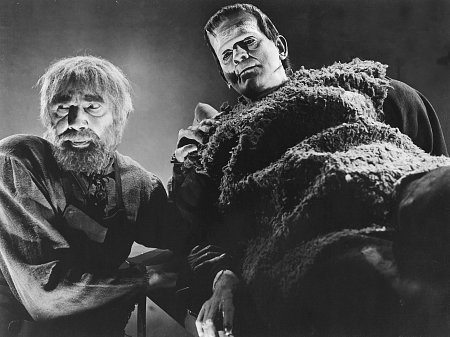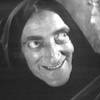The very title of the new computer-animated film IGOR represents a sort of final proof – as if any were needed – that the most mysterious example of mistaken identity in the history of horror cinema is firmly embedded in the public consciousness beyond any hope of repair. The mystery: How did the name “Igor” come to be the generic designation for a mad scientist’s hump-backed assistant? In fact, how did mad scientists come to have assistants at all?
The famous scientists and semi-scientists of fiction tended to be loners. Dr. Moreau had Montgomery, but Dr. Jekyll, Frankenstein, and Griffin (the Invisible Man) worked in isolation. It is really the movies that established the concept of the deformed, grave-robbing assistant, thanks to 1931’s FRANKENSTEIN. But that character was called Fritz – not Igor. How did he come to be, and how did he his name come to be replaced?
Looking for literary antecedents, one might cite Quasimodo in Victor Hugo’s Notre Dame de Paris (more popularly known in English as The Hunchback of Notre Dame). Quasimodo does not serve a scientist, but he is a second banana to a villainous character, Claude Frollo, a religious man corrupted by his lust for the gypsy girl Esmerelda. IN 1925, Universal Pictures, the company that later made FRANKENSTEIN, turned The Hunchback of Notre Dame into a film starring the “Man of a Thousand Faces,” Lon Chaney. Although not actually a horror film, the elaborate Gothic sets and the makeup for the misshapen title character served as an influence on Universal’s horror classics of the 1930s, and one cannot help suspecting that a bit of Quasimodo found his way into Fritz.
When Universal made FRANKENSTEIN, little of Mary Shelly’s 1818 novel remained; the film was heavily influenced by intervening stage productions, some of which included an assistant. The dramatic reasons for this were obvious: in the book, Frankenstein could tell us his story directly, revealing what was going on in his mind; on stage and on film, Frankenstein’s character could be better revealed to the audience by giving him another character with whom to interact.

Another influence on Fritz was undoubtedly Renfield, the vampire’s obsessed acolyte in Bram Stoker’s novel Dracula. The film version had been a hit for Universal in 1931, directly leading to the production of FRANKENSTEIN later that year. In the earlier film, Count Dracula is served by a dangerous lunatic, played by Dwight Frye; attempting to recapture DRACULA’s successful formula, Universal cast Frye as Fritz. Frye brought along the nervous qualities of his Renfield performance, playing Fritz, like Renfield, as a character who is subservient in the presence of his master but eager to dominate when on his own. In fact, the sadistic hunchback inadvertently causes his own death, torturing Frankenstein’s creation until the artificially created man lashes out in self-defense.
It is safe to say that the popular image of the mad scientist’s assistant derives almost entirely from Fritz: unpleasant, uncouth, ugly, possibly dangerous but for the most part loyal to his master. Frye played a slightly cleaner variation on the character in the 1935 sequel BRIDE OF FRANKENSTEIN, but the next big step in the evolution from Fritz to Igor was 1939’s SON OF FRANKENSTEIN. In that film, Bela Lugosi co-starred as a broken-necked shepherd who used to steal bodies for Frankenstein.

Lugosi’s character is named Ygor (with a “Y”), but he is not quite the assistant as we commonly know him. For one thing, he has his own agenda: using the monster to kill off the people who sentenced him to be hanged. He works with Frankenstein’s son, not out of loyalty but only out of a desire to restore the monster to full power. Nevertheless, in other regards, he fits the mold: he’s a lower-class peasant whose shaggy appearance and unkempt clothing visually distinguish him from the upper-class scientist he serves.
How the name “Ygor” (respelled “Igor”) came to replace “Fritz” in the public consciousness is a bit of a puzzle. Subsequent Universal FRANKENSTEIN film featured assistants and/or hunchbacks, but none of them were named either “Ygor” or “Igor.” Over a decade latter, when England’s Hammer Films made THE CURSE OF FRANKENSTEIN (1957) – and, later, its sequels – they avoided the cliche of the deformed assistant. The Italian horror film BLACK SUNDAY (1960, originally La Maschera Del Demonia [“The Mask of the Demon”]) featured a character named Igor Yavutich, but he served at the leisure of a vampire-witch, not a mad doctor; in any case, his name was shorted to simply Yavuto in the Americanized release prints, omiting his first name, so he had little influence on American perception that “Igor” equates with sinister servant. Eventually, the stop-motion kid-flick MAD MONSTER PARTY (1969) featured a creepy assistant named “Yetch,” which seems to be almost a conflation of “Ygor” and “Fritz.” (This film also popularized the notion of the assistant speaking in a nasal voice reminiscent of actor Peter Lorre.)
However it happened, the name Igor (if not the precise identity) seems to have been embedded in the public consciousness by the late 1950s, by which time it was appearing in pop culture spin-offs. The 1958 novelty record “Dinner with Drac” – by the “Cool Ghoul,” John Zacherle – has the narrator admonishing a waiter, “Igor, the scalpels go on the left, with the pitchforks!” The line suggests a bumbling assistant but not a mad scientist’s assistant, since Frankenstein is never mentioned.
Four years later, Bobby “Boris” Picket vamped a line or two during the fade-out of his hit single “The Monster Mash,” using the name “Igor” to refer not to a hunch-backed helper but to Frankenstein’s Monster. However, the follow-up album, The Original Monster Mash, contains several tracks identifying Igor as a lowly assistant, including “Irresistible Igor,” which specifically mentions the grave-robbing activities associated with the character in the old Universal Frankenstein films. Igor himself is even heard grunting, “Master!” once or twice – a line borrowed from Dwight Frye’s Renfield, but which has since become thoroughly associated with Igor and his ilk.
Perhaps what really sealed the deal was the kids’ lunchbox that Universal Studios licensed in the 1960s, featuring images of their classic movie monsters. Beside Frankenstein’s creation stood a very Fritz-like hunchback – identified as Igor! Presumably, Universal had decided that “Fritz” was too prosaic; let’s face it, “Igor” is a better name for a sinister servant. Or perhaps the then-current Universal brass simply did not recall that the character had originally been called “Fitz.”

Whatever the reason, the name was so firmly established that, by the time Mel Brooks got around to spoofing the genre with YOUNG FRANKENSTEIN (1974), Mary Feldman’s character (clearly modeled on Frye’s Fritz, not Lugosi’s Ygor) is named “Igor,” and the name itself becomes the subject of a joke, when the character insists on pronouncing it “Eye-gore.”
Since then, the humpbacked assistant has been a bit of a joke; his very familiarity evokes laughter rather than fear, as when one wanders briefly into TIM BURTON’S THE NIGHTMARE BEFORE CHRISTMAS, huffing (in a Peter Lorre voice), “Master! The plans, the plans!” By the time Hollywood got around to making a film specifically about the mad doctor’s servant, it was inevitable that the title would be IGOR; nobody would know what the film was about if it were named “Fritz.” While IGOR turns the concept of the loyal assistant on its head (the title character wants to be an inventor, nore a mere helper), it is interesting to note that the film’s very title represents the culminating step in a similar inversion, the rechristening of a classic horror movie character with a name not originally his own.
This article was updated on May 6, 2014, to include mention of “Dinner with Drac” and “The Monster Mash.”


